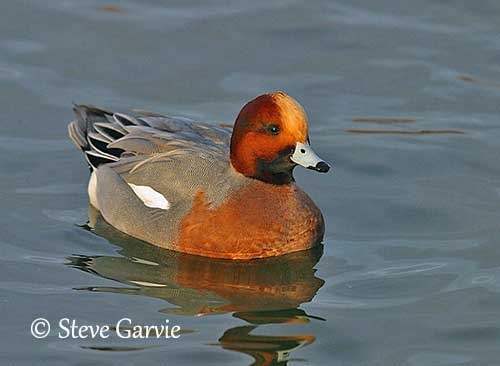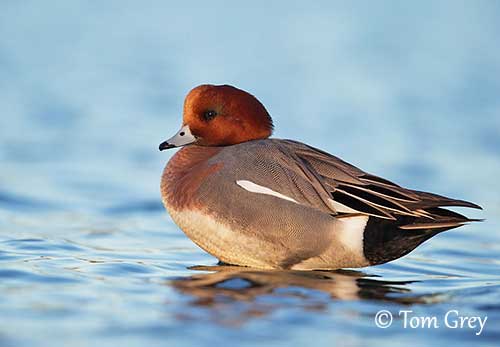
Fr: Canard siffleur
Ang: Eurasian Wigeon
All: Pfeifente
Esp: Silbón Europeo
Ita: Fischione
Nd: Smient
Sd: bläsand
Photographers:
John Anderson
John Anderson Photo Galleries
Steve Garvie
RAINBIRDER Photo galleries & Flickr Rainbirder
Tom Grey
Tom Grey's Bird Pictures & Tom Grey's Bird Pictures 2
Otto Plantema
Trips around the world
Ingo Waschkies
Bird Photography
Text by Nicole Bouglouan
Sources:
HANDBOOK OF THE BIRDS OF THE WORLD vol 1 by Josep del Hoyo-Andrew Elliot-Jordi Sargatal - Lynx Edicions - ISBN: 8487334105
FIELD GUIDE TO THE BIRDS OF NORTH AMERICA - National Geographic Society -ISBN: 0792274512
GUIDE DES CANARDS, DES OIES ET DES CYGNES – de Steve Madge - Delachaux et Niestlé - ISBN: 2603013769
ENCYCLOPEDIE DES OISEAUX DE FRANCE ET D’EUROPE – de Peter Hayman et Rob Hume - Flammarion – ISBN : 2082009920
THE COMPLETE BOOK OF BRITISH BIRDS – Written by “Royal Society for the Protection of Birds” experts - Préface de Magnus Magnusson - Michael Cady- Rob Hume Editors - ISBN: 0749509112
THE HANDBOOK OF BIRD IDENTIFICATION FOR EUROPE AND THE WESTERN PALEARCTIC by Mark Beaman, Steve Madge - C. Helm - ISBN: 0713639601
BIRDS OF THE MIDDLE EAST by R.F. Porter, S. Christensen, P Schiermacker-Ansen C.Helm - ISBN: 0713670169
A Field Guide to the Birds of South-East Asia by Craig Robson. New Holland Publishers. ISBN: 9781780090498
Bird Web (Seattle Audubon Society)
What Bird-The ultimate Bird Guide (Mitchell Waite)
Wikipedia, the free encyclopaedia
All About Birds (Cornell Lab of Ornithology)
South Dakota Birds and Birding – (Terry L. Sohl)
Bird Words - The official site of Dominic Couzens, natural history writer
Eurasian Wigeon
Mareca penelope
Anseriformes Order – Anatidae Family
INTRODUCTION:
The Eurasian Wigeon breeds in the northernmost regions of Europe and Asia. It migrates S after breeding to spend the winter in warmer areas in Asia and Africa. It is also an uncommon winter visitor in North America, from Canada to California. This species breeds by small lakes and marshes, and usually avoids open tundra, densely forested and mountainous areas. During winter, it can be seen in estuaries, bays, and flooded meadows.
The Eurasian Wigeon is vulnerable to disturbance from recreational activities, pollution, drainage of wetlands, degradation of the habitat and hunting pressure.
The overall population trend is decreasing, although the North American population is increasing. But the Eurasian Wigeon is not currently globally threatened.

DESCRIPTION OF THE BIRD:
Biometrics:
Length: 45-51 cm
Wingspan: 75-86 cm
Weight: M: 600-1000 g – F: 500-800 g
The Eurasian Wigeon adult male in breeding plumage has grey and white vermiculated upperparts and flanks. On the upperwing, there is a white patch on the upperwing-coverts, visible at rest. We can see the elongated grey scapular feathers and a dark green speculum, bordered with black on both sides. The primaries are greyish-brown. The long, grey, tapered tertials are edged with white, and the outer webs are black. The rump is white and contrasts with the black area surrounding the pale grey and white tail.
On the underparts, upper breast and breast sides are pinkish-grey. Lower breast and belly are white and contrasts with the black area around the tail. The flanks are vermiculated grey and white. Axillaries and underwing-coverts are whitish, with fine brownish mottling. The flight feathers are darker.
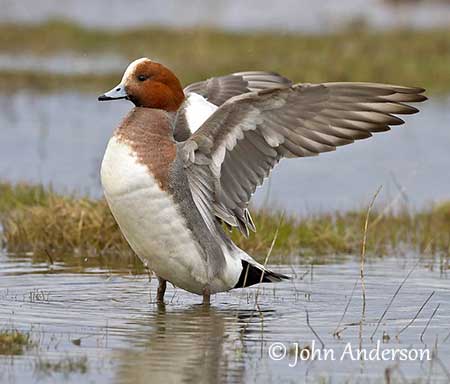
Head and neck are chestnut with creamy-white to pale yellowish crown. We can see sometimes a metallic, dark green spot behind the eye and on the throat.
The bill is pale blue with black tip. The eyes are dark brown. Legs and webbed feet are slate grey.
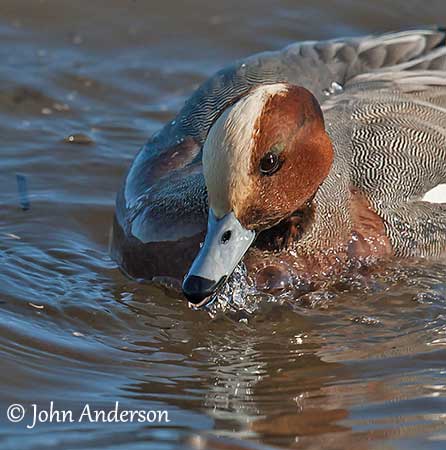
The adult male in eclipse has rich reddish-chestnut plumage, but the upperparts are darker than in female. The flanks are rufous and contrast with the white forewing. The dark area around the tail shows white-edged black feathers.
The adult female is rather variable, with grey or rufous upperparts contrasting with the whitish belly. Her body appears more uniform, although finely mottled. The underwing is fawn-coloured with pale markings and the axillaries are greyish. The speculum is blackish and the wing-coverts are grey-brown. Bill, legs and feet are dull blue-grey.
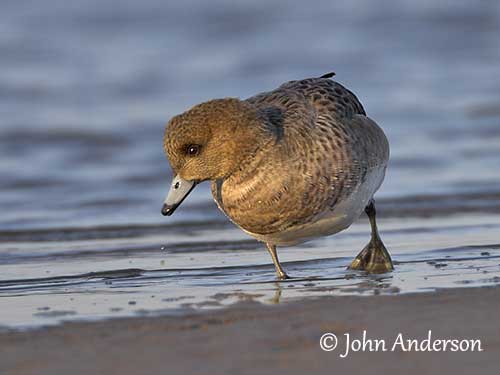
The juvenile resembles female but it has mottled belly. The first winter male is very similar to the adult, but it acquires the white forewing only in second winter. The first winter female is slightly duller than adult female.
RANGE:
The Eurasian Wigeon breeds from Iceland and N Britain, E through N Europe and N Asia, to Pacific coast. It winters in C and S Europe, S Asia and N and C Africa. It also reaches North America where it occurs from Canada to California.
HABITAT:
The Eurasian Wigeon breeds by marshes and lakes in open or sparsely wooded area. During winter, it often moves to coastal marshes, estuaries and sheltered bays. It also frequents seasonally flooded meadows and estuarine grasslands.
This species is visible up to 3700 metres of elevation in Ethiopia and up to 2700 metres in Kenya.
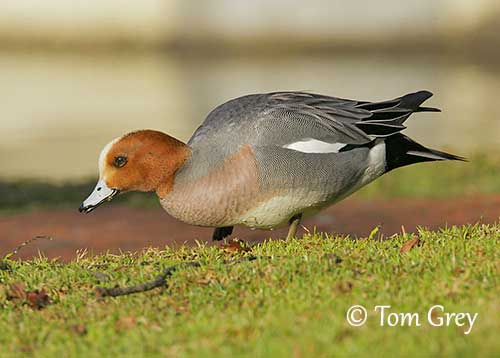
CALLS AND SONGS: SOUNDS BY XENO-CANTO
The Eurasian Wigeon male utters a piercing, whistling “whee-OO” both in flight and on the water. We can also hear a softer “whut-whittoo”
The female produces a low, growling “krrr” also given when flushed.
BEHAVIOUR IN THE WILD:
The Eurasian Wigeon feeds primarily on plant material, and consumes a wide variety of leaves, stems, roots, seeds and algae. Some insects can be taken in summer.
It forages by grazing on land, but also by dabbling in shallow water, sometimes submerging head and neck to reach the food underwater. In deeper water, it may perform upending, but rather rarely. It may sometimes steal food to other species, often geese and coots. This species feeds both by day and night.
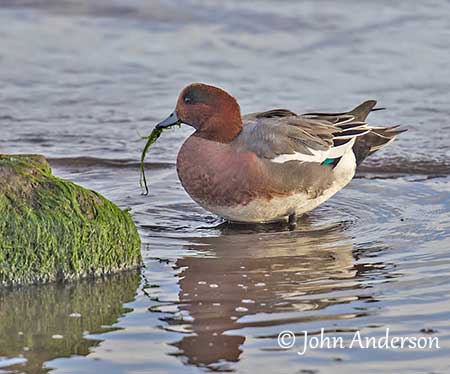
Like numerous duck species, the Eurasian Wigeon males court one female and compete with each other. The displaying male lifts the tips of the folded wings, in order to display the white wing patch. The head is raised while it utters its whistling call. Then, the bill is lowered to enhance the crown patch in front of the female.
The pairs often form on the wintering areas. They are monogamous and the pair-bond is maintained until soon after the clutch is initiated. However, they may return together during winter.
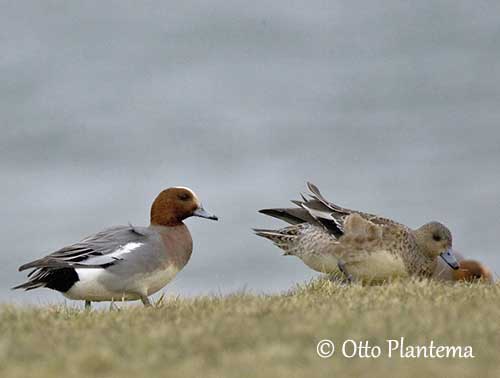
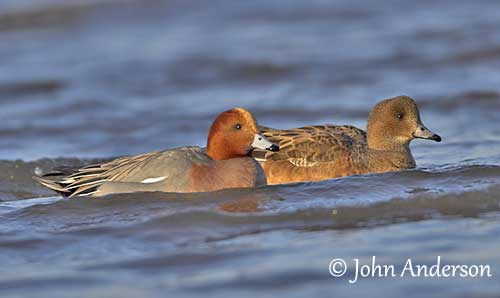
The males gather in flocks for moulting at the beginning of the reproduction, and the females tend the young alone.
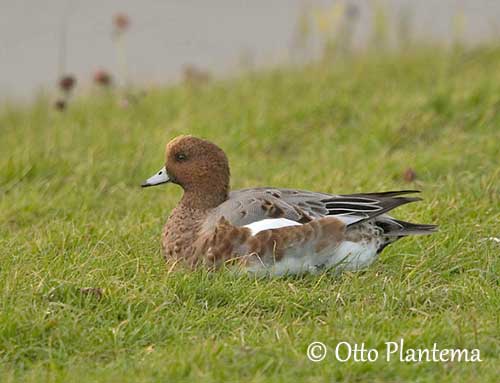
The Eurasian Wigeon is migratory and spends the winter in more temperate regions. The British population is mostly sedentary and only performs short-distance movements. They are highly gregarious outside breeding season, and often form large flocks.
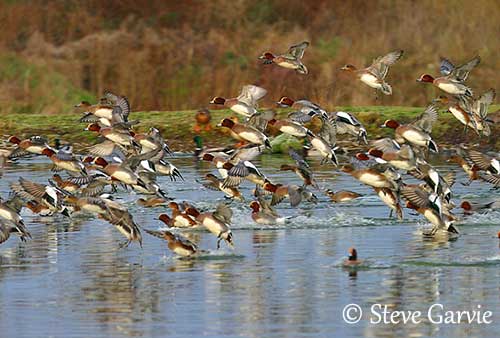
They arrive on the breeding grounds in April/May, and reach their wintering areas in late August/September. They fly in compact groups or irregular lines.
The Eurasian Wigeon has swift, direct flight with rapid wingbeats.
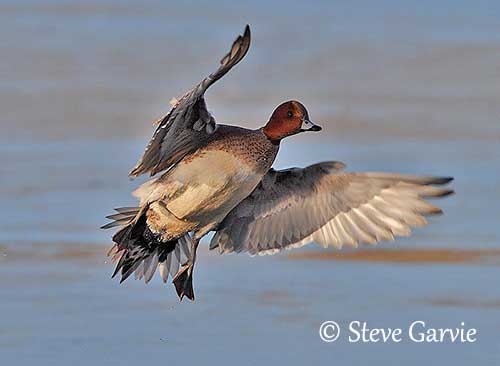
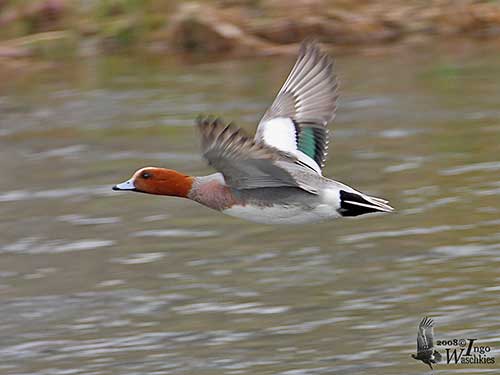
REPRODUCTION OF THIS SPECIES:
The breeding season starts in April/June, but it may vary according to the range, with nests in April in Scotland, but only in late May in N Russia. The Eurasian Wigeon nests in single pairs or small groups, with nests less than 5 metres from each other.
The nest is on the ground, hidden under dense vegetation. It is a depression lined with grass and a thick layer of down. It is usually close to the water, but sometimes distant of up to 250 metres.
The female lays 8-9 whitish to creamy-white eggs. She incubates alone during 24-25 days. At hatching, the chicks have pale brown down above and paler below. They have grey bill, brown eyes and olive-brown legs and feet. They leave the nest very soon after hatching and remain with the female until they fledge, about 40-45 days later.
This species produces one, sometimes two broods per season, but a replacement clutch is laid if the first is lost.
The Eurasian Wigeon is very similar to the American Wigeon (Anas Americana) and both species hybridize regularly.
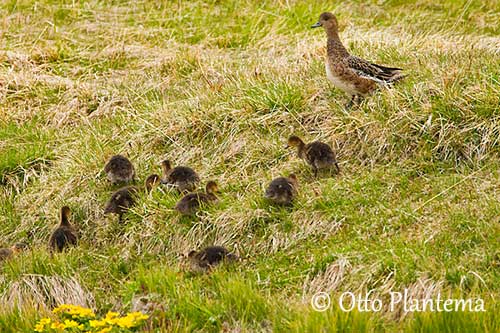
PROTECTION / THREATS / STATUS:
The Eurasian Wigeon is vulnerable to predation by Corvidae and Mustelids, involving nest desertion. But the species is also threatened by increasing freshwater recreational activities, drainage of wetlands, pollution, and invasive plant species following the decrease of grazing in meadows. It also suffers from hunting pressure in the UK and in Iran.
The global population was estimated to number 2,800,000/3,300,000 individuals in 2006. This population is suspected to be decreasing, except in North America.
But currently, the Eurasian Wigeon is evaluated as Least Concern.
